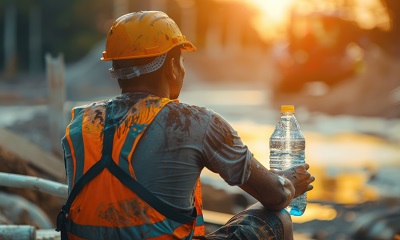Challenges Facing Remote Workers Exposed to Extreme Heat Conditions
Australia’s outdoor workforce faces unique and demanding challenges, particularly for those working in remote locations where extreme heat is a threat. From construction sites and mining operations to agricultural fields and road maintenance crews, working in high temperatures poses significant risks to health, safety, and productivity. For occupational health and safety managers, understanding these challenges and implementing effective strategies is critical to protecting workers and ensuring operational effectiveness.
Recognising Heat-related Illness
There are several factors which can affect workers that will also impact the individual in different ways. According to SafeWork Australia the problem is heightened once a person is past the dehydration stage, when their ability to self-assess will be affected from symptoms such as;
- confusion
- fatigue
- loss of concentration
- poor judgement
- dizziness and fainting

Prolonged exposure to high temperatures can lead to heat-related illnesses such as heat exhaustion and heatstroke. These conditions not only compromise worker health but can also result in reduced productivity, fatigue, and an increased likelihood of accidents. For remote workers, the risks are intensified by limited access to immediate medical assistance or cooling facilities.
Education and Training
*Between 2001 and 2013, extreme environmental heat was responsible for the deaths of 13 workers in Australia, with countless others suffering from heat stress and dehydration.
Themes that emerged from the coronial inquiries into the 13 work-related fatalities (noting that 12 of these deaths resulted from working outdoors) included:
- in cases of workers with colleagues nearby, there was a failure to recognise the signs of heat-related illness
- workers working alone either failed to recognise or to act on their symptoms or were unable to call for help
- the need for systems to identify when a worker is suffering heat-related illness and allow them to seek assistance if isolated.
Businesses must know when their workers are at risk of sun and heat exposure and ensure they have plans and systems in place to reduce the risks. Focusing on the hierarchy of controls there are some basic elements which all workers should know including being able to identify the signs of heat-related illness and know how to identify signs in co-workers, including what immediate first aid to give a worker and when to call for further medical assistance.
Wearable Devices
In addition, monitoring devices can be used to understand more about the environment and its effect on workers. Wearable technology is emerging as a game-changing solution to monitor and mitigate the effects of heat stress. These devices, equipped with advanced sensors, can track critical vital signs such as heart rate, core body temperature, and hydration levels to provide real-time alerts, reminders, recommendations and support on hydration levels for those working in remote areas. When workers approach dangerous thresholds, wearable devices alert the worker to enable immediate action helping to prevent dehydration, heat-related illnesses, and in extreme cases death.
For more information on how to assess risks and what plans you need to implement please speak to an Occupational Hygienist, you can find one in your area by accessing the AIOH (Australian Institute of Occupational Hygienists) here.
If you would like more information on wearable monitoring devices please get in contact with your local AES Office.
Information and guidance from:
*https://www.safework.nsw.gov.au/resource-library/heat-and-environment/working-in-extreme-heat-the-facts?